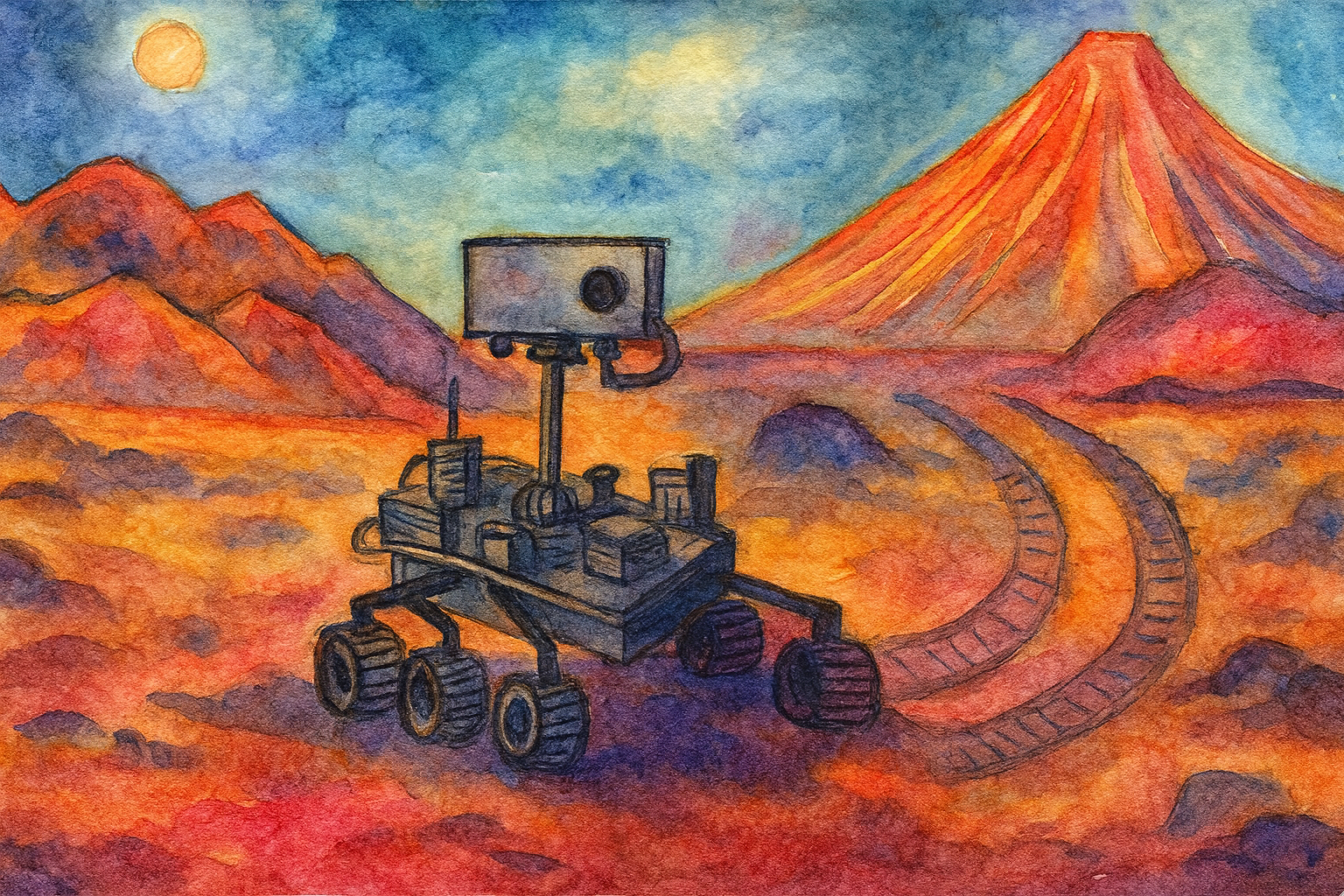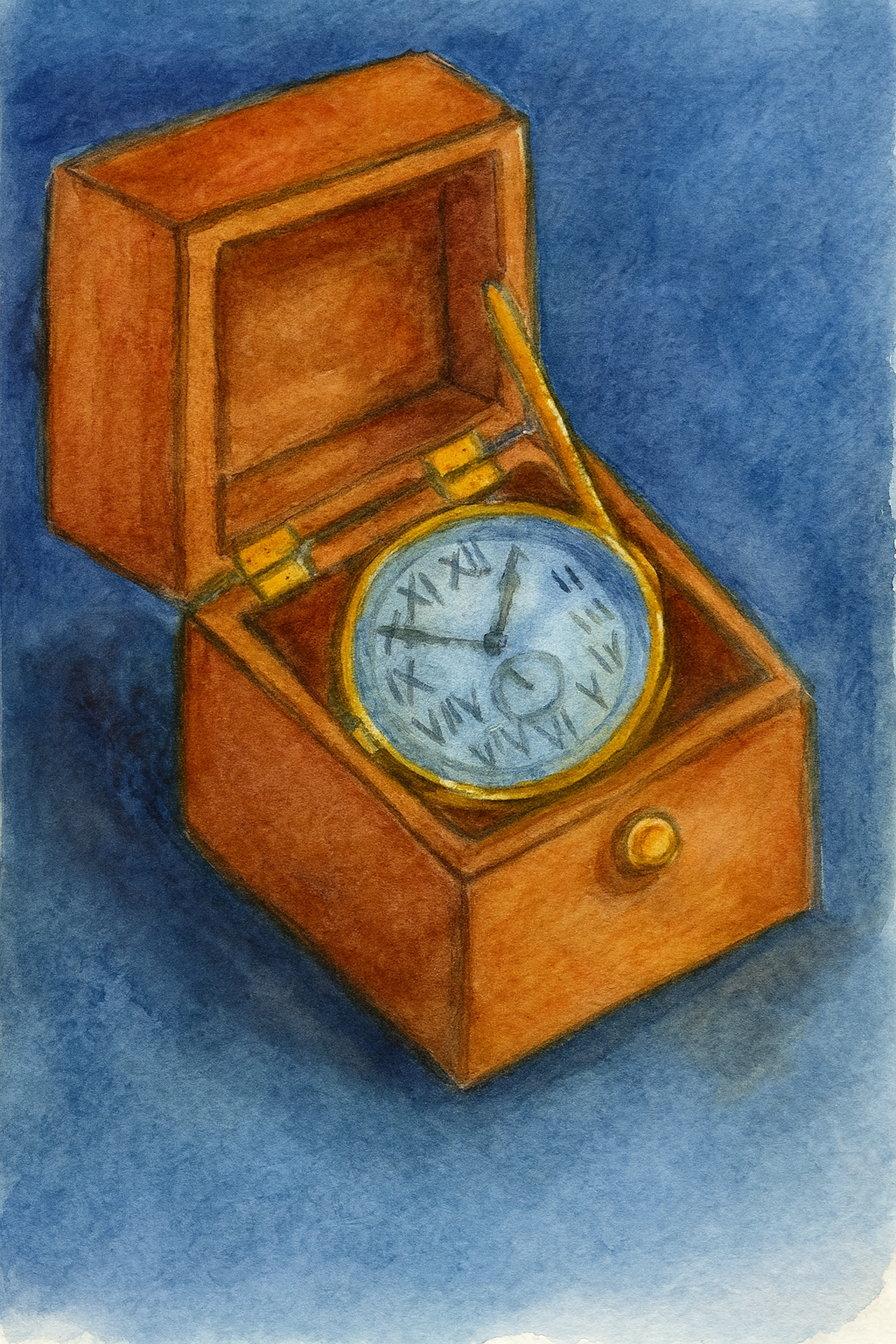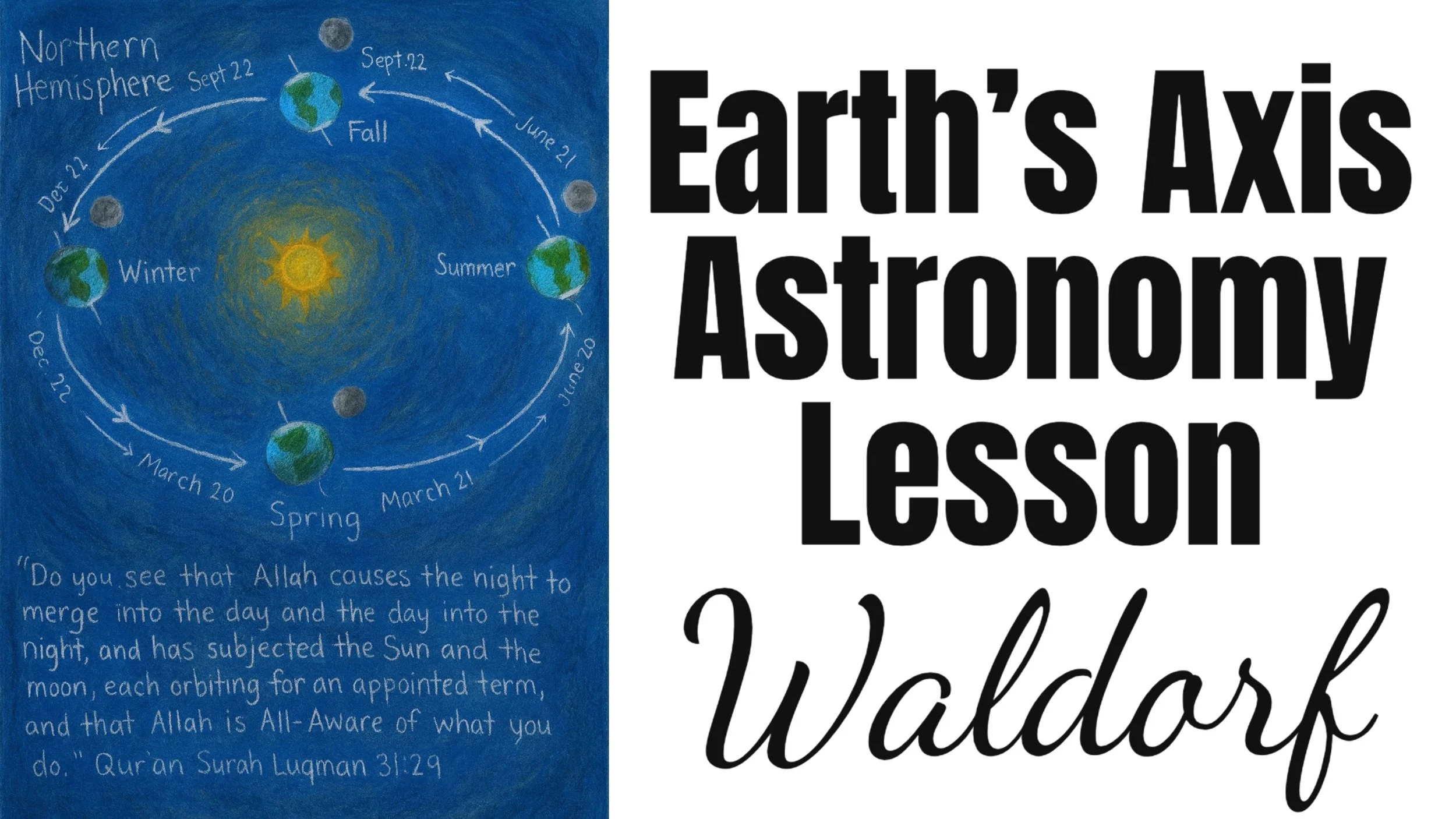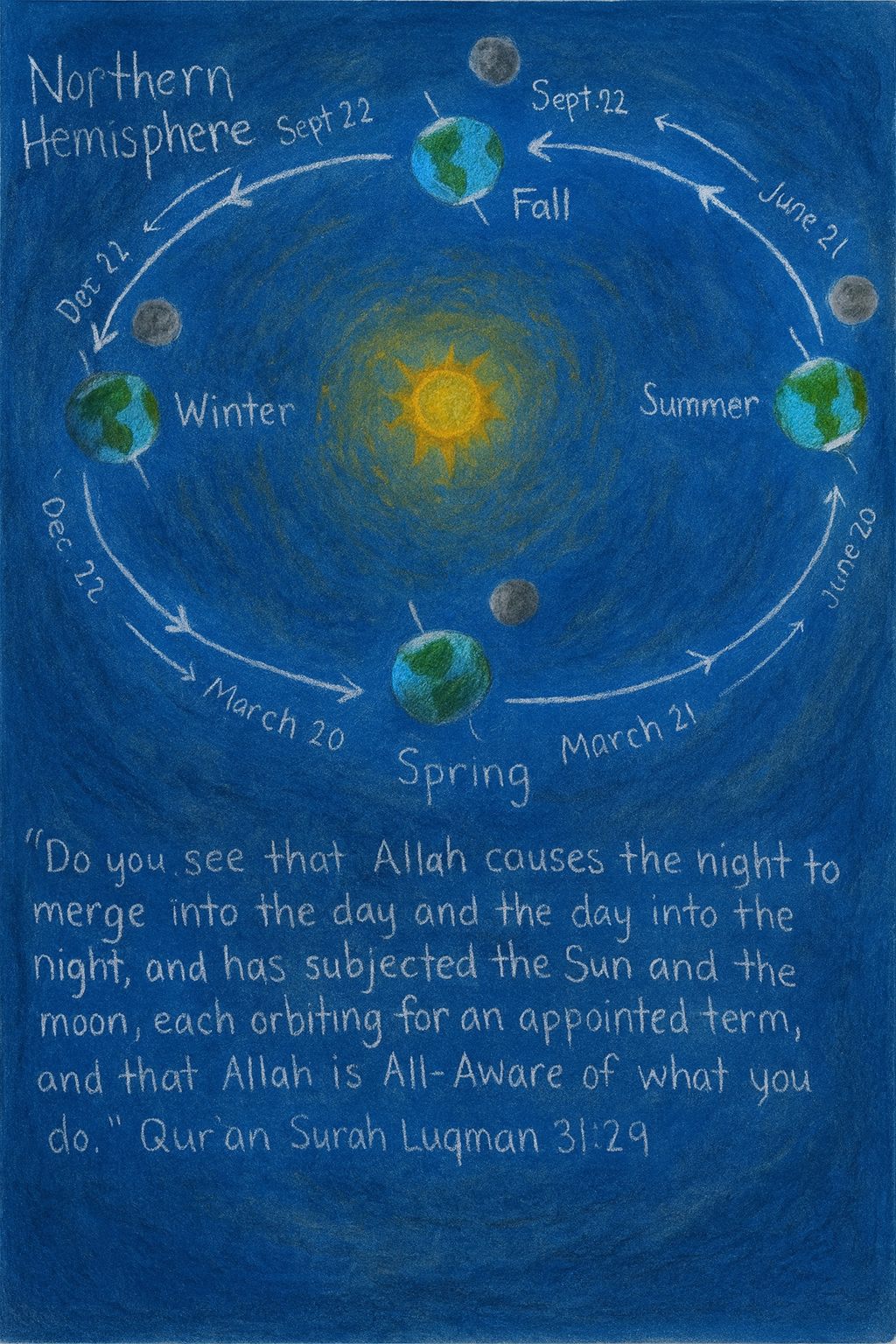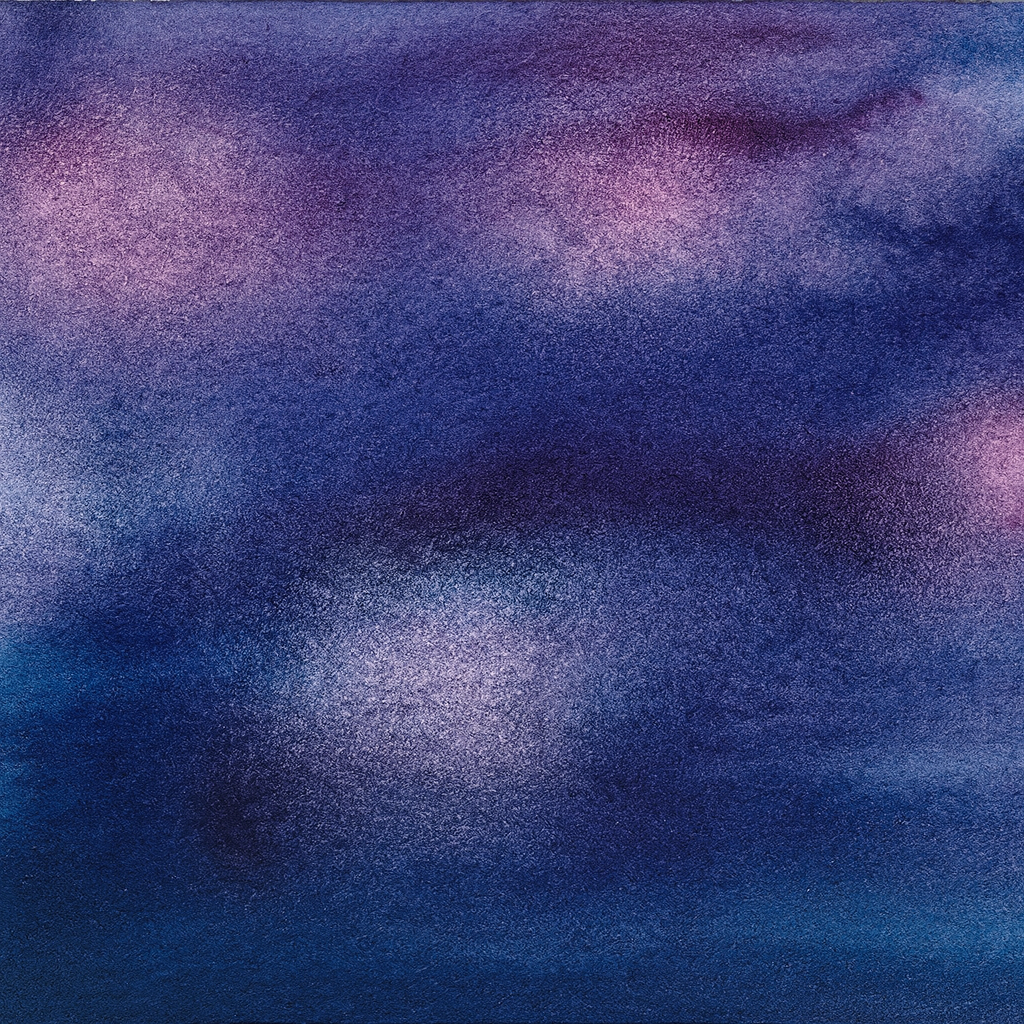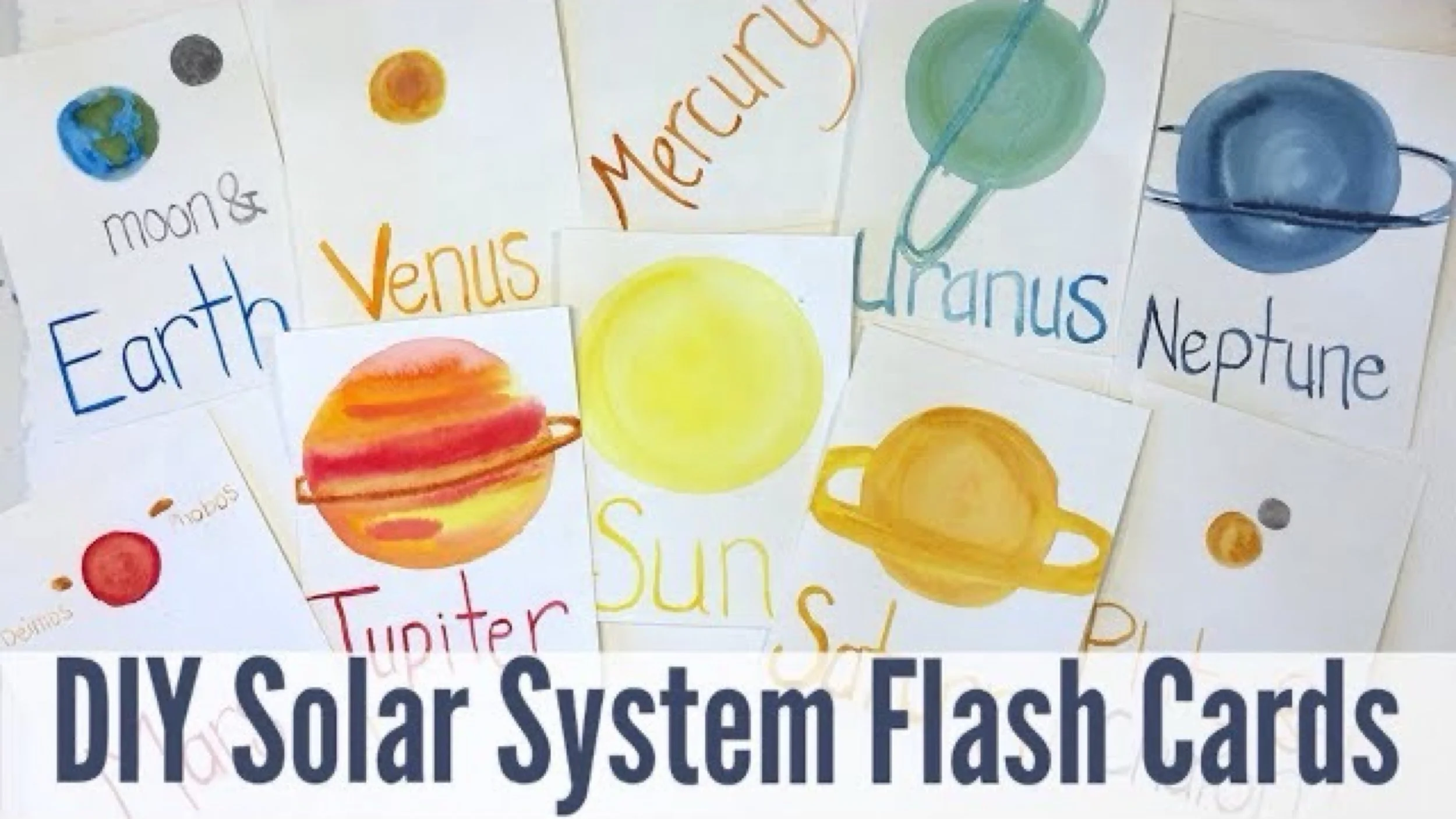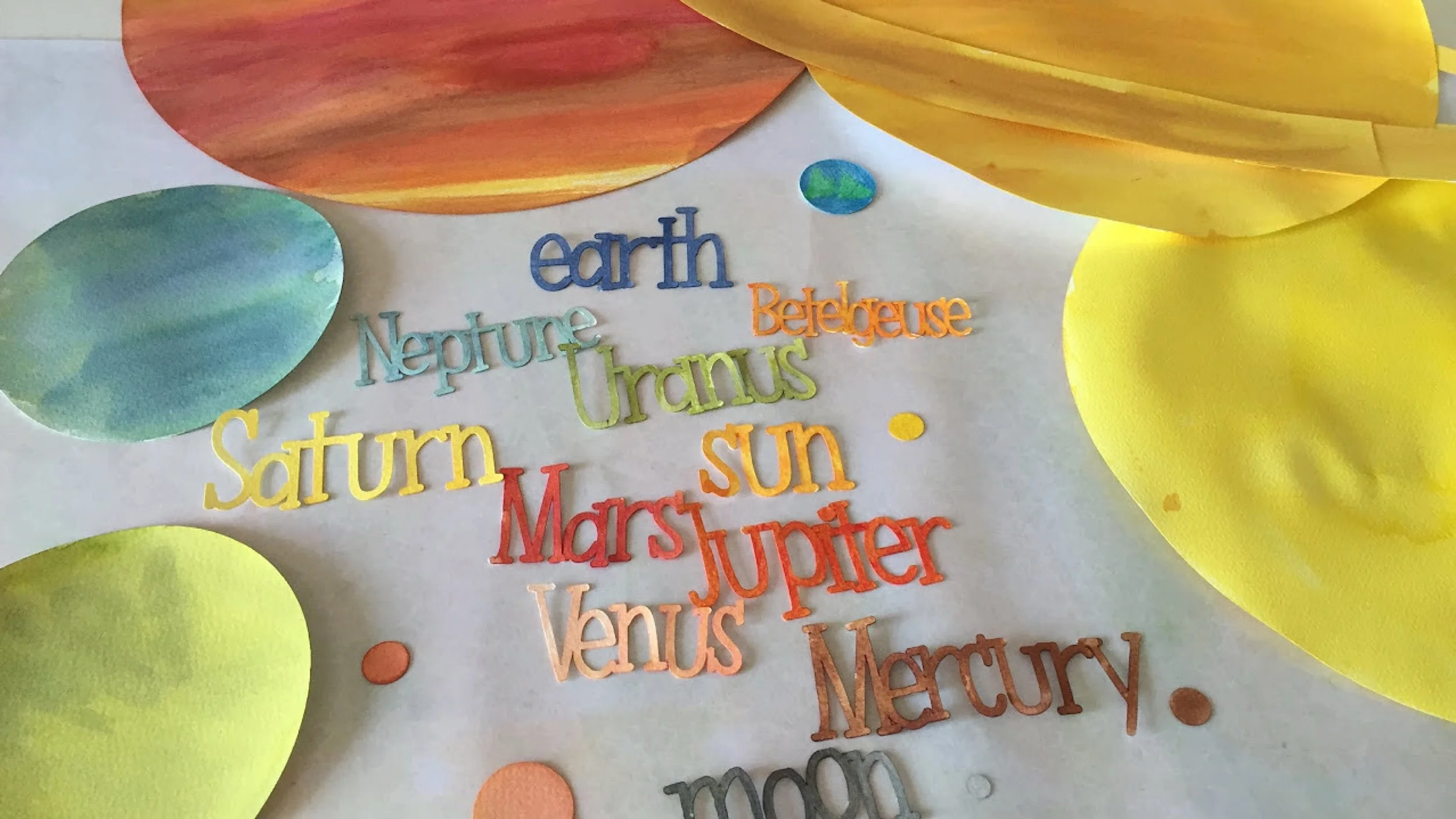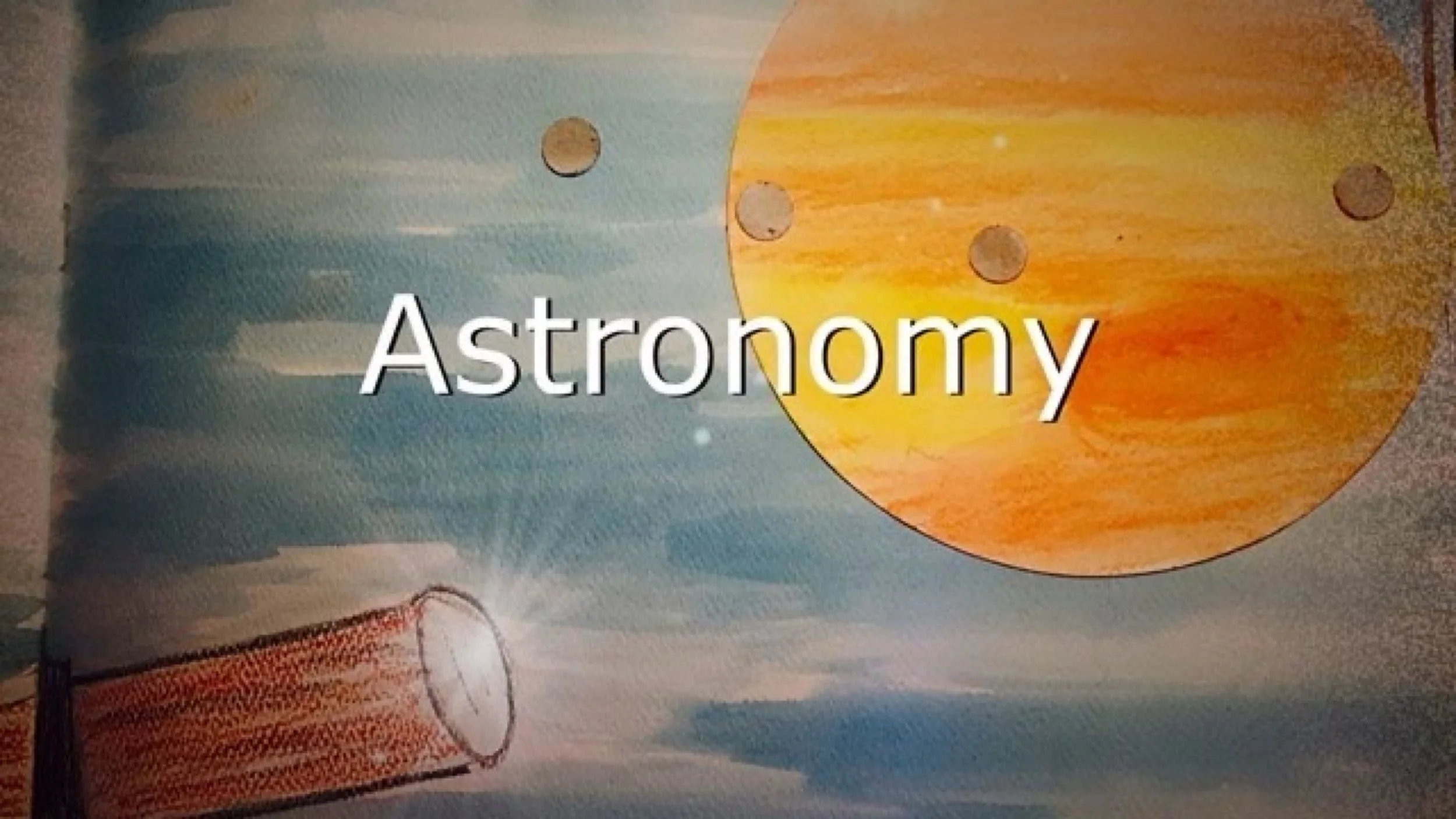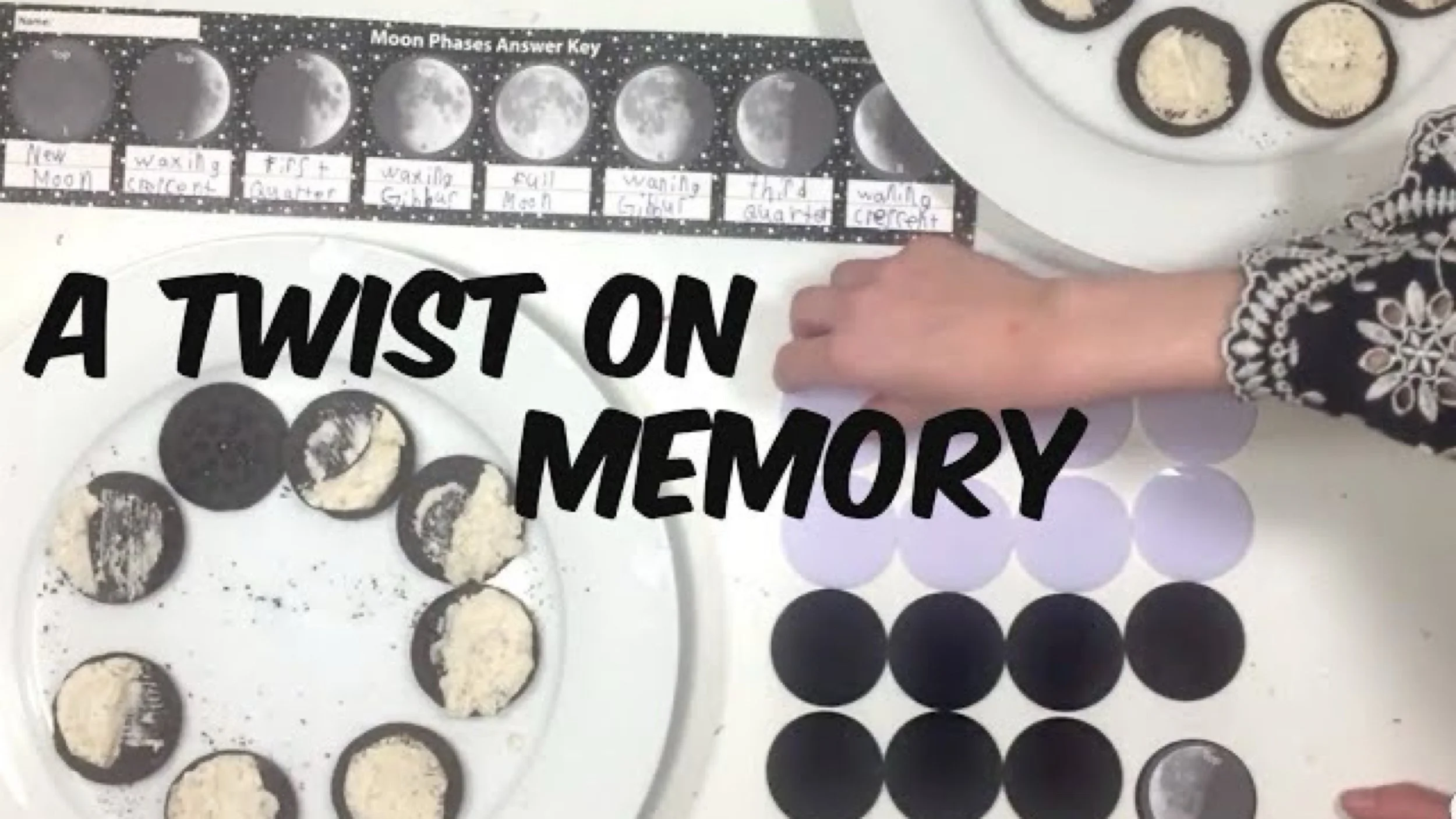
Astronomy Lessons
Lessons
I’m doing our lessons for a Waldorf main lesson block in astronomy, I shared two types. The first type is a real time live lesson that I do with the children, the second type is an overview of the lesson content, which includes the written narration and the illustration which you can find in a main lesson book. While I do use the chalkboard for chalk drawings, lately I have been using a main lesson book to do written narration and illustrations in advance of preparing the lesson. This helps collect my thoughts for the lesson and at other times, it provides a written narration that my daughter can review before writing her own original narration. It also allows us to have illustrations that can be copied, even when we move onto a new lesson. This has become convenient for us as I currently just have the one chalkboard.
In the past, when I had more chalkboards, I might’ve had more chalk drawings up for multiple lessons as the children got caught up with their lesson book work. It’s very easy for us to present a lesson, but it takes a lot more time to do the written work for the lesson and the illustration for the lesson. Sometimes if they weren’t done with that work, it would hold up The next lesson. So, writing in a main lesson book has relieved us of that problem.
Astronomy Lessons
-
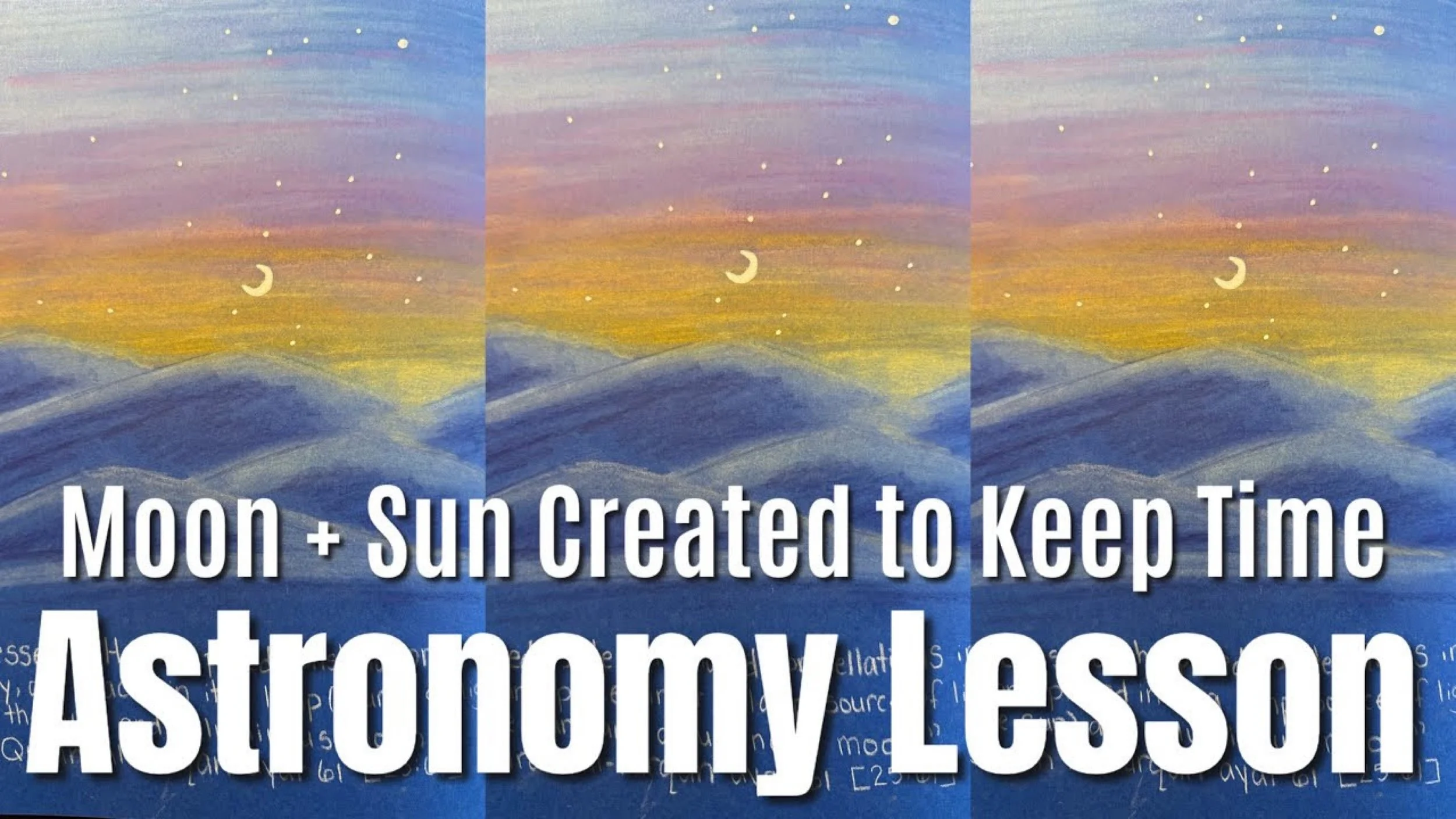
Astronomy lesson Sun, Moon, Stars for keeping time
For our first lesson in astronomy, we chose to include a religious aspect by adding verses from the Quran as part of the content. In the, Quran 6:96 Allah says, "He is the One Who makes the dawn break; He has set the night for rest, and the sun and moon for reckoning."
-

Latitude, Longitude and the North Star | Waldorf Astronomy Lesson
In this lesson for our astronomy main lesson block, we introduce the concept of the imaginary lines of latitude and longitude. Included in this lesson is a religious component. We included verse from the Quran, Surah 6 ayat 97.
-
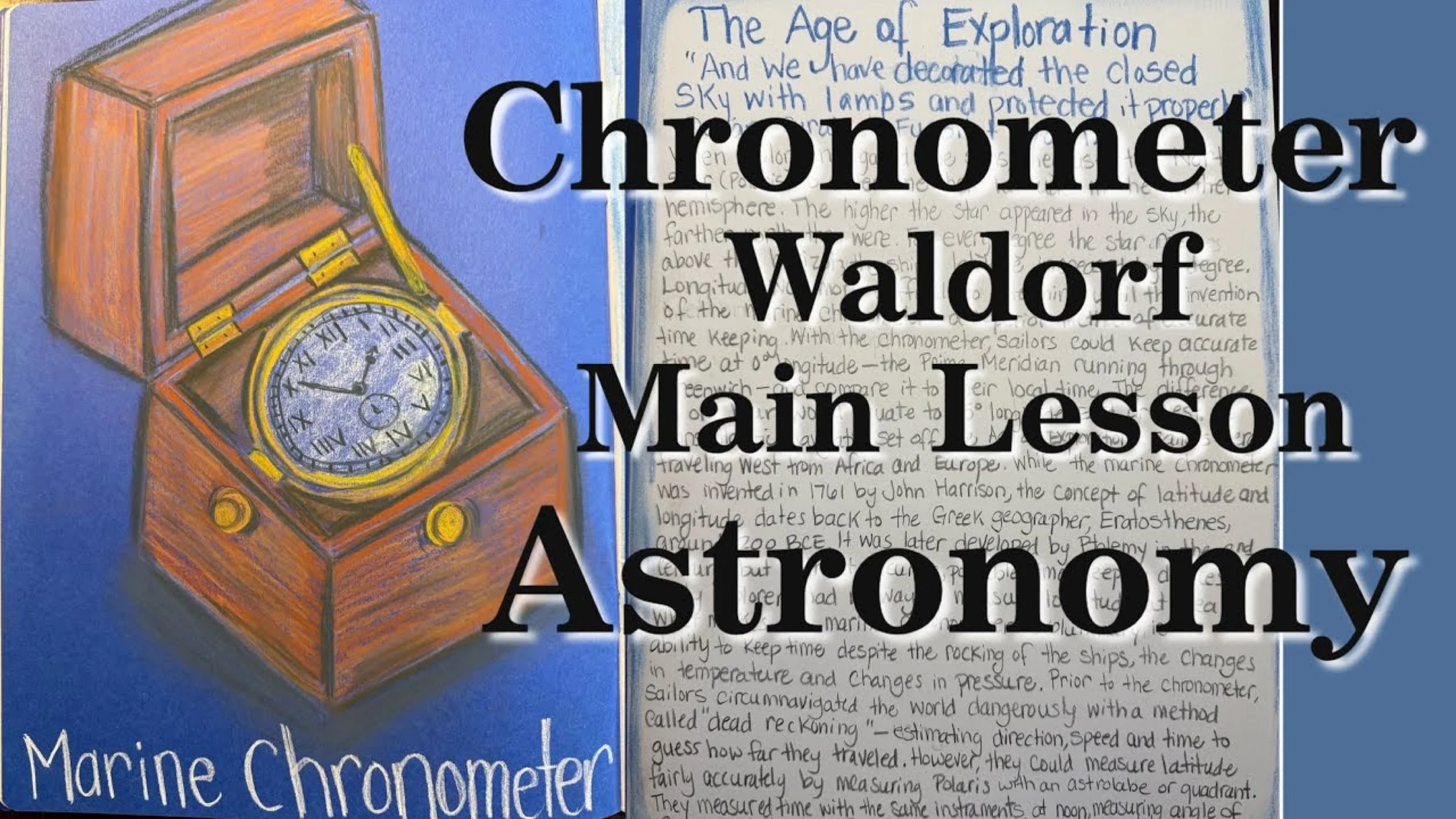
The Chronometer and Age of Exploration | Waldorf Astronomy Lesson
In 1761, John Harrison invented the chronometer. This device allowed sailors to accurately measure time while on the open sea. Thermometer was able to keep time even during stormy weather when the boat was rocking back-and-forth, and even with temperature changes or pressure changes.
-
Earth's Axis | Waldorf Main Lesson | Astronomy
We did this lesson three ways. The first part of the lesson is an oral delivery of the lesson and explaining about the earth seasons and the earth's axis. This is still quite abstract for the student, even though the student is in middle school and is prepared to take on more abstract concepts.
-
Four Seasons of Southern California | Waldorf Astronomy Lesson
The four seasons, as experienced in Southern California are different than in other parts of the world or the country. While there may be some similarities, I was really excited to focus specifically on how we experience Southern California weather throughout the four seasons, especially in the chaparral.
-
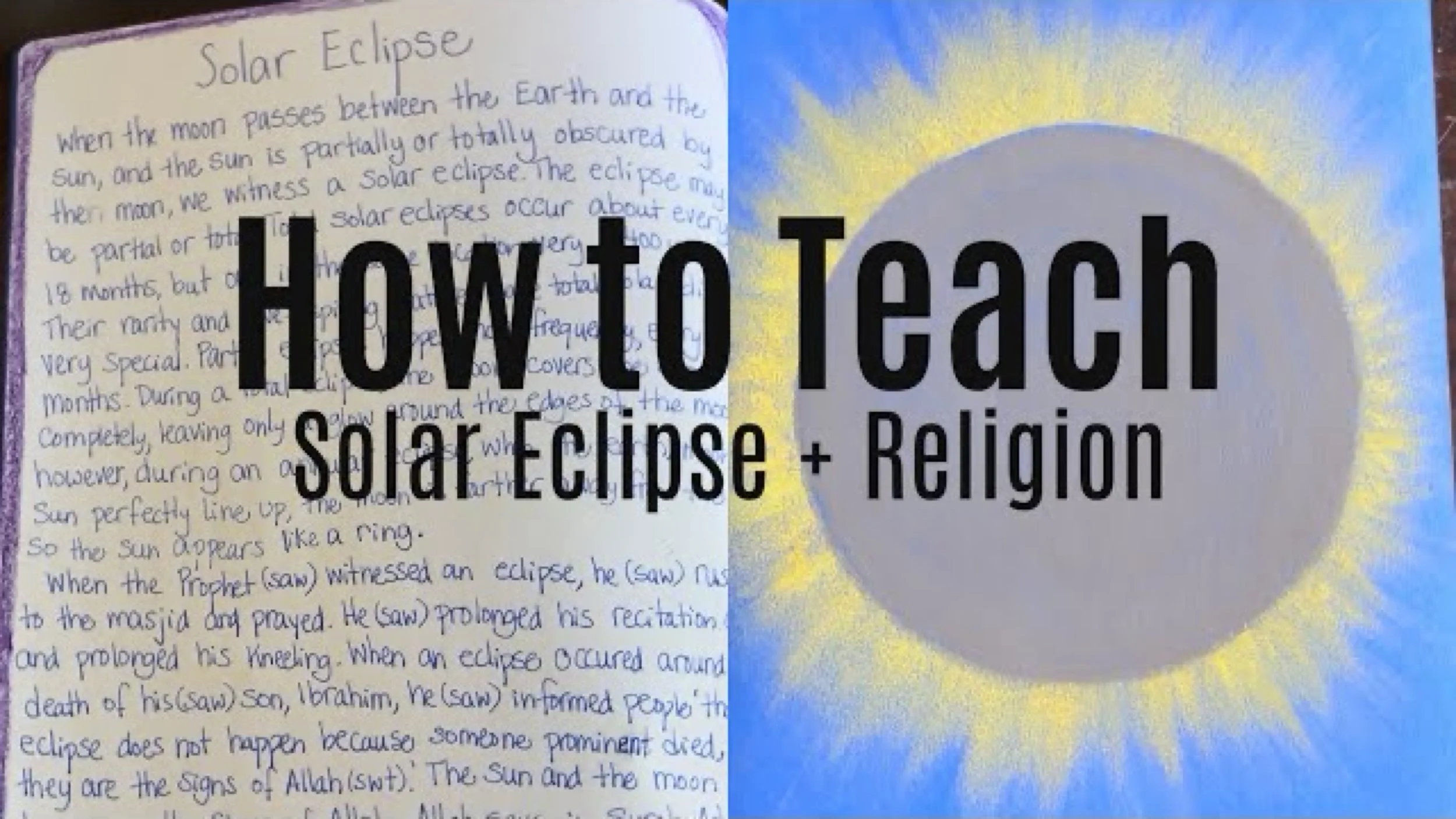
Total Solar Eclipse
Having just experienced a partial solar eclipse, we used it to work on an Astronomy lesson prior to the formal start of this main lesson block. In the video I share a bit about the Muslim prayer during an eclipse. It is a special prayer that is offered in congregation at the masjid, and read aloud.
-

Homeschool Lesson | Astronomy
What do you mean every lesson isn't 'perfect'? Why would you show such a failure, I mean, what's the point? I had high hopes for this lesson, I mean after all, I successfully did it the last time we did the main lesson block. So what changed? I
-
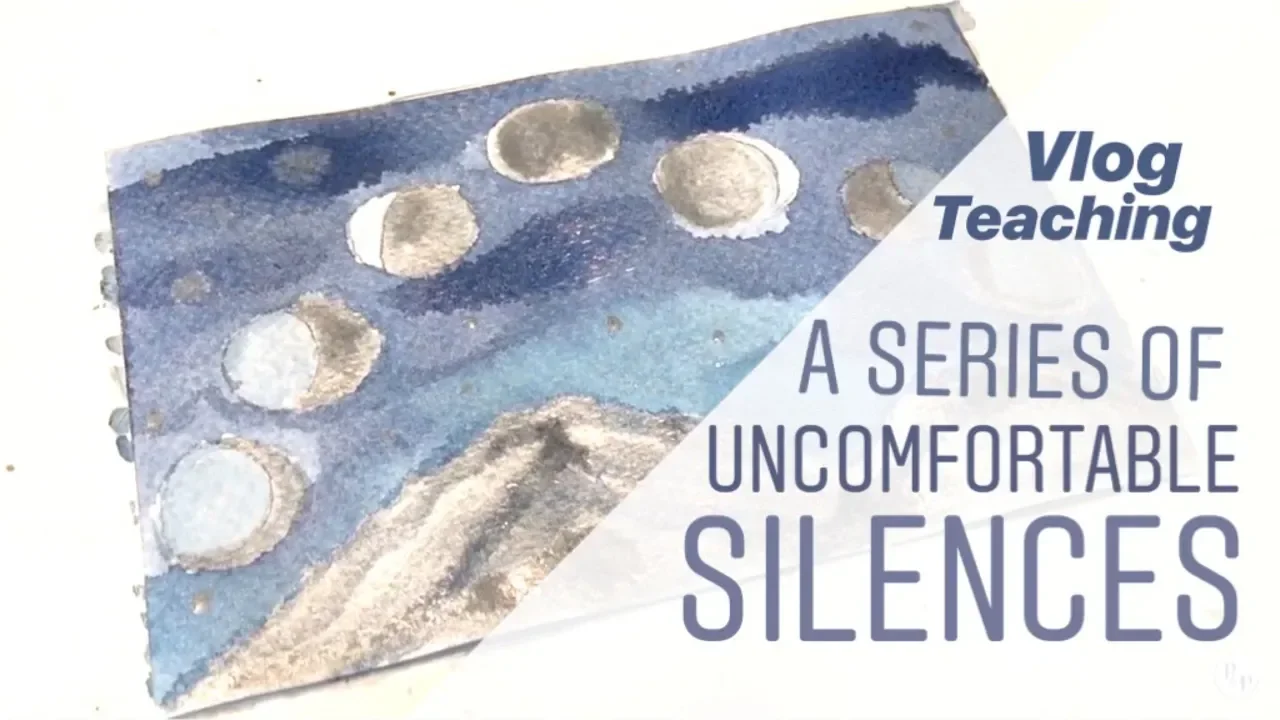
Homeschool Teaching Vlog | 1st Grade
So this is what teaching really looks like in our homeschool. Since we don't have any more babies or toddlers, the silences between instructions appear painfully long when viewing this video. But rather than edit them out, I thought I'd leave them in, so you can get an almost true view of what our homeschool looks like.

Astronomy Lessons
Astronomy Lesson
Sun, Moon, Stars for Keeping Time
For our first lesson in astronomy, we chose to include a religious aspect by adding verses from the Quran as part of the content. In the, Quran 6:96 Allah says, "He is the One Who makes the dawn break; He has set the night for rest, and the sun and moon for reckoning." This verse speaks about God's creation and His purpose in creating the night for rest and the sun and moon for reckoning or calculation.
In the time prior to Islam, in 500s Arabia, the Quraysh used to manipulate the calendar so that the lunar months matched with the solar calendar. However, the Quraysh tribe and other Arabs did not have a formal, distinct “solar calendar” with a specific name as we understand it today (like “Gregorian”). However, they primarily used a lunar calendar, similar to the current Islamic (Hijri) calendar, but with the following significant, and eventually forbidden, difference: they occasionally adjusted the lunar calendar to align with the solar year for practical reasons like coordinating the Hajj season and trade seasons.
This system was known as “Nasi’” meaning “postponement” or “delay.” It allowed them to intercalate (add) a month every few years to keep the lunar calendar in sync with the solar seasons, essentially creating a lunisolar system. Not unlike leap year or leap century
The Quran forbid this practice in Surah At-Tawbah 9:37
“Indeed, the postponing [of a month] is an increase in disbelief…”
We are working in an astronomy main lesson which measures 9.5”x12” and contains white blank pages for writing narrations and blue construction paper for illustrations. You can find the main lesson books at A Child’s Dream.
We are using chalk pastels for our illustrations. We are using two brands: General’s and Stabillo.
The blog post that accompanies this video covers the Waldorf pedagogical approach to teaching Astronomy to student aged 11-13 in great detail as well as provide non-Waldorf resources for an Astronomy unit study for elementary and middle school aged students.
Latitude, Longitude & the North Star
In this lesson for our astronomy main lesson block, we introduce the concept of the imaginary lines of latitude and longitude. Included in this lesson is a religious component. We included verse from the Quran, Surah 6 ayat 97. For this lesson, we discuss how the Constellations and specifically the Northstar our means of guidance for travelers, sailors and explorers when traversing in the darkness of the land or Sea. The invention of the Cronometer, quadrant and lines of latitude, longitude allowed sailors to locate their position on the open sea, and successfully navigate transatlantic crossing. 
We are working in an astronomy main lesson which measures 9.5”x12” and contains white blank pages for writing narrations and blue construction paper for illustrations. You can find the main lesson books at A Child’s Dream.
We are using chalk pastels for our illustrations. We are using two brands: General’s and Stabillo.
The blog post that accompanies this video covers the Waldorf pedagogical approach to teaching Astronomy to student aged 11-13 in great detail as well as provide non-Waldorf resources for an Astronomy unit study for elementary and middle school aged students.
The Chronometer & Age of Exploration
In 1761, John Harrison invented the chronometer. This device allowed sailors to accurately measure time while on the open sea. Thermometer was able to keep time even during stormy weather when the boat was rocking back-and-forth, and even with temperature changes or pressure changes. Prior to the invention of the chronometer, sailors used one of two methods to to determine their location. Dead reckoning is a method sailors used to approximate their location based on their speed, direction and time. Another method was to use a quadrant or Astrolabe to measure the ascension of the sun at noon and compare the results to timetables. When comparing the data to the measurements, sailors were able to tell how many degrees west they had sailed. Both these methods were inaccurate and resulted in mini ships that were either lost at sea, never arrived at their destination for be became shipwrecked. Despite all of these challenges, explores successfully circumnavigated the planet.
We are working in an astronomy main lesson which measures 9.5”x12” and contains white blank pages for writing narrations and blue construction paper for illustrations. You can find the main lesson books at A Child’s Dream.
We are using chalk pastels for our illustrations. We are using two brands: General’s and Stabillo.
The blog post that accompanies this video covers the Waldorf pedagogical approach to teaching Astronomy to student aged 11-13 in great detail as well as provide non-Waldorf resources for an Astronomy unit study for elementary and middle school aged students.
Astronomy Lesson
Earth's Axis
It may seem like a simple lesson, but discussing the seasons and the Earth axis can be a complicated concept for students to understand. For this reason, we did this lesson three ways. The first part of the lesson is an oral delivery of the lesson and explaining about the earth seasons and the earth's axis. This is still quite abstract for the student, even though the student is in middle school and is prepared to take on more abstract concepts.
The next part of the lesson is to do an illustration of the earth's axis on its path around the sun. In this illustration, I drew the Earth four times to indicate the different seasons. Still this part of the lesson feels Abstract and not as relatable as doing a hands-on project. The hands-on project that we do for this lesson is to take a globe that is already set at a 23 1/2° tilt and in a darken room flash, a light onto the Earth as you take that model of the Earth around the light source. As the “earth “travels around the light source you can see clearly how the light shines on the northern hemisphere more so at one time and shines on the southern hemisphere more so at another time.
While students have been experiencing the season since they were young, especially if they live farther away from the earth's equator, after doing a less of like this, we become more focused and aware of the seasons.
We are working in an astronomy main lesson which measures 9.5”x12” and contains white blank pages for writing narrations and blue construction paper for illustrations. You can find the main lesson books at A Child’s Dream.
We are using chalk pastels for our illustrations. We are using two brands: General’s and Stabillo.
The blog post that accompanies this video covers the Waldorf pedagogical approach to teaching Astronomy to student aged 11-13 in great detail as well as provide non-Waldorf resources for an Astronomy unit study for elementary and middle school aged students.
Astronomy Lesson
Four Seasons of Southern California
The four seasons, as experienced in Southern California are different than in other parts of the world or the country. While there may be some similarities, I was really excited to focus specifically on how we experience Southern California weather throughout the four seasons, especially in the chaparral. Deserts get up to 10 inches of rain a year whereas the chaparral gets slightly more rain per year. We come in at around 11 inches per year, which means that we are not living in a desert. However, we do have some desert conditions. The first thing is that we will experience cool evenings throughout the entire year. Even if it is scorching hot in the summer once the sun goes down we experience lovely, cool, beautiful weather.
Our rainy season is in the winter. Usually the month of January is our coldest wettest month.
Spring emerges in February and we have a beautiful cool weather for months. Enterprising Lee, the months of May and June end up being cloudy, overcast and cooler than you would expect for Southern California. However, by July summer is in full swing! Temperature sore into August. And when you think The hot days will cool down once fall starts in September and October, you’ll be in for an unexpected surprise. September and October are second summer. Temperatures can get even hotter than July and August. But, at least by November and December we are experiencing fall weather. Leaves that have changed colors earlier in the season are ready to fall from the trees, and while we will still have warm weather, the first chill is felt.
Fall is fire season. After nearly 7 to 10 months of hot, dry weather, the brush is easy to ignite. Every year, somewhere in California there is a brush fire. How much burns and how quickly it is extinguished is dependent on several factors, including: Area of fire, type of brush, the last time it experienced fire, how dry or humid the environment is, and how quickly it can be contained. One thing we hope for when fire season breaks out is an early rain. Rain is one of the best ways to combat and out of control brushfire.
We are working in an astronomy main lesson which measures 9.5”x12” and contains white blank pages for writing narrations and blue construction paper for illustrations. You can find the main lesson books at A Child’s Dream.
We are using chalk pastels for our illustrations. We are using two brands: General’s and Stabillo.
The blog post that accompanies this video covers the Waldorf pedagogical approach to teaching Astronomy to student aged 11-13 in great detail as well as provide non-Waldorf resources for an Astronomy unit study for elementary and middle school aged students.
Total Solar Eclipse
Having just experienced a partial solar eclipse, we used it to work on an Astronomy lesson prior to the formal start of this main lesson block. In the video I share a bit about the Muslim prayer during an eclipse. It is a special prayer that is offered in congregation at the masjid, and read aloud. The 2-ruka prayer is elongated during ruku and sujood, allowing extra time for dua. A significant difference is that there are two ruku for each sujood, so this two-ruka prayer has 4 ruku and 4 qiam rather than 2 and 2. For a complete description and explanation, please refer to this video.
For this lesson, we referred to online resources for the specificities of solar eclipses, then referred to specific hadith for the Islamic portion of this lesson. Art inspiration for this lesson came from a content creator on Instagram. We are using our Main Lesson Books from A Child’s Dream. These measure 9 inches by 12 inches and are the astronomy books which contain a blue page for astronomy constellations and a white page for written narration. While this size main lesson book is often used in grade 5 or younger, I find them to be a suitable size through middle school. This lesson accompanies our Astronomy unit and you can see the rest of the videos on YouTube. Find me one X, Instagram, Facebook, YouTube, and TikTok
We are working in an astronomy main lesson which measures 9.5”x12” and contains white blank pages for writing narrations and blue construction paper for illustrations. You can find the main lesson books at A Child’s Dream.
We are using chalk pastels for our illustrations. We are using two brands: General’s and Stabillo.
The blog post that accompanies this video covers the Waldorf pedagogical approach to teaching Astronomy to student aged 11-13 in great detail as well as provide non-Waldorf resources for an Astronomy unit study for elementary and middle school aged students.
Live Homeschool Astronomy Lesson
What do you mean every lesson isn’t ‘perfect’? Why would you show such a failure, I mean, what’s the point? I had high hopes for this lesson, I mean after all, I successfully did it the last time we did the main lesson block. So what changed? I can’t say for sure, but I couldn’t live up to my previous self from years ago. How does that even happen?! Well, all the components were in place. All the materials were selected. Everything was ‘perfectly’ arranged and ready to go. Learning and art were to be married in this lesson on the Great Bear constellation. Well, see for yourself. I think I might have been the problem. Maybe my expectations were too high for myself. Maybe I wasn’t in the right mental space to do this lesson, either way, we threw in the towel and didn’t bother looking back. Check out the complete Astronomy main lesson block playlist.
The blog post that accompanies this video covers the Waldorf pedagogical approach to teaching Astronomy to student aged 11-13 in great detail as well as provide non-Waldorf resources for an Astronomy unit study for elementary and middle school aged students.
Homeschool Teaching Vlog
1st Grade
So this is what teaching really looks like in our homeschool. Since we don't have any more babies or toddlers, the silences between instructions appear painfully long when viewing this video. But rather than edit them out, I thought I'd leave them in, so you can get an almost true view of what our homeschool looks like. I recorded this video to be a time-lapse video with a voice over, so the words you hear are mine, live and unedited and not projecting so if you really want to hear what's going up, turn up the volume or plug in some earbuds. The sound isn't as loud or clear or free of background noise. That's my real life. My 11-year-old son chose not to join my 7-year-old daughter and me for this project, but you can hear him working on his own paper crafting project in the background. To see 'behind-the-scenes' pictures of what's going on in the background, head on over to my website and check out the blog post that accompanies this video.
For the past several years I've been scrapbooking our Ramadan. This year I didn't prepare at all to do it. In fact, I haven't scrapbooked since last Ramadan. I'm so sad about that. So today, my daughter and I decided to scrapbook. Actually, it was her idea and she insisted on it. I'm glad she did. Together we worked on an intro card for a Ramadan scrapbook. She was mildly interested in it, but really would have preferred to scour my extensive stash of supplies, explore them, discover 'new' things and create her own designs. So indeed she did do just that as soon as this 'lesson' was done. She sifted through my project life cards, glitter glue and more. She created so many little cards that day. And I made two. She was happy and excited, but ran into problems when her designs didn't match what she envisioned. Working through that is challenging with a strong willed determined child. In part I want to walk her through process and show her some basic skills, on the other hand, I want her to find her own creative path. The middle ground is to let her do her own thing and catch her before she gets frustrated with her design or abilities. At that point, I stop what I'm doing and help her achieve the look she wants. It's not always successful, but I'm learning, just as she is.
She wasn't interested in doing the moon phases scrapbook card. Once she saw mine, she said she liked it better. I told her we can trade. That usually works. Anyway, I like my kids' work. It's not perfect, it's not a master piece, but neither are mine. She's quite tied to the outcome of a project. I think it's because she forms a picture in her head of what she wants it to look like. When it doesn't look that way, it disappoints her.
For today's project, I'm using Fabriano 90lb. watercolor paper from the 9"x12" pad cut down to 4"x6" rectangles. We are using budget paint brushes. Are watercolors are Distress Re-Inkers and Distress Sprays in Broken China, Chipped Sapphire, Faded Jeans, Denim, and Brushed Silver. The embellishments at the end were from my scrapbooking stash; the letters were from Doodlebug Designs circa 2003 and are no longer available.
Projects & Activities
